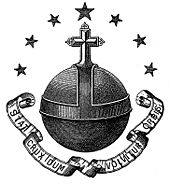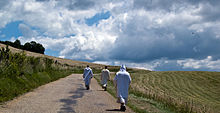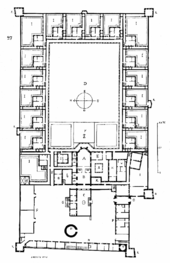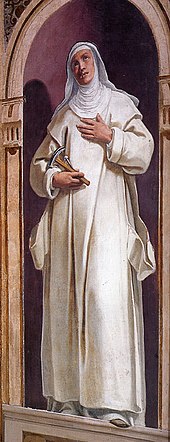Carthusian
The Carthusians ( Latin Ordo Cartusiensis , order abbreviation OCart ) are an order in the Roman Catholic Church that combines the hermitic with the cenobitic way of life. The order goes back to St. Bruno of Cologne . The Carthusian motto is: Stat crux dum volvitur orbis (The cross is fixed while the world turns).
history

founding
In 1084 St. Bruno of Cologne , the founder of the Carthusian Order, withdrew with six companions to the Chartreuse , a lonely mountain area near Grenoble in France . The land was made available to them by Saint Hugo (around 1053–1132), the then Bishop of Grenoble, based on a vision . In a dream he had seen seven stars settle in La Chartreuse . Bruno and his companions built small hermitages as well as the common rooms and a church necessary for a monastery . All rooms were connected by a cloister . Soon more men joined them. The community grew and La Grande Chartreuse , the Great Charterhouse , the mother monastery of the Carthusian Order, emerged and gave the order its name.
Bruno himself did not write a rule of the order. The way of life of the first hermits should simply be adopted by all future ones. Only after men in other countries followed the way of life of St. Bruno did the Carthusian lifestyle have to be put down in writing. In 1127, for example, St. Guigo de Chastel , who was the fifth prior of the Grand Charterhouse from 1109 to 1136 , wrote the Consuetudines Cartusiae , the customs of the Carthusians. In 1133 the rule was approved by Pope Innocent II . 1170 the community of Pope Alexander III. recognized as an order. Further changes were made in 1259 (Statuta antiqua) , 1367 (Statuta nova) , 1509 (Tertia compilatio statutorum) and 1581 (Nova collectia statutorum ordinis cartusiensis) .
In 1145, women who adopted the Carthusian way of life joined forces for the first time and thus founded the female branch of the order. In the 18th century there were five Carthusian monasteries.
Despite the strict way of life, the order expanded rapidly from around 1200 after some initial difficulties. There were four Carthusian monasteries in 1137, 14 in 1151 and finally 56 in 1258, 175 in the 14th century and 220 in the 15th century. The order had its heyday in the late Middle Ages at the time of mysticism (wave of founding around 1480). The movement of the Devotio moderna , in the course of which the phenomenon of the city carthusians arose , had a special influence on the development of the order . Up until that time, Carthusian monks were founded in remote areas, but now there have been new foundations in cities, for example in London and Cologne. Carthusian cities became centers of humanism . The order was divided into a Roman and an Avignon branch between 1378 and 1415 during the Great Occidental Schism . After the end of the schism, the two competing General Superiors resigned, and Johannes von Grazienburg took the helm of the order. In 1508 the Pope determined that the prior of the Chartreuse should always lead the Carthusian monks.
reformation
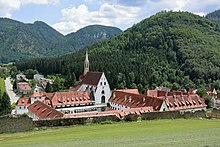
The Reformation led to a sharp decline in the order in the Protestant areas in the 16th century. Since then, the number of Carthusian monks and nuns has stagnated or has fallen continuously. In England, the Carthusians were persecuted under King Henry VIII for refusing to recognize him as head of the Church of England. The king acted particularly brutally against the monks of the London Charterhouse. In the wake of the Enlightenment, the benefit was contemplative Carthusian questioned and canceled many charterhouses, such as 1782 by Emperor Joseph II. Through education, Josephinism , French Revolution and the Reichsdeputationshauptschluss the number of charterhouses fell again sharply (while still in 1700 168).
present
In Germany, with the secularization, all Kartausen were abolished. In 1869 the Maria Hain Charterhouse was founded in Unterrath near Düsseldorf as a new Charterhouse on German soil. During the National Socialist era , resistance fighters were able to hide in the Great Charterhouse .
Today the Carthusian monks - next to the Cistercians more strictly observant - are the only male order that has retained the high medieval ideal of a strictly contemplative life. Other originally contemplative orders, such as Benedictines and Cistercians , have opened up to the world in the course of their history and have taken on tasks primarily in the areas of pastoral care and teaching.
In 2004 the Carthusian monasteries counted 18 monasteries and 4 nunneries, in which 335 brothers (including 170 priest monks) and 48 nuns lived. In the past 50 years the order has lost about 50% of its membership. There are branches in Europe , America and Asia . In the German-speaking area there is a Carthusian male monastery, the Marienau Charterhouse , in Bad Wurzach , Baden-Württemberg . It was founded in 1964 to replace the Maria Hain Charterhouse near Düsseldorf, which was built in 1869 , as the Carthusians had to withdraw there due to the expansion of the airport .
Monks
“Our endeavors and our calling consist primarily of finding God in silence and solitude” (Statutes 12: 1). The search for God in silence and solitude is common to all Carthusians. Depending on suitability and personal mentality, the individual Carthusian lives his calling. The Carthusians therefore distinguish three types of monks :
- Priest monks ( lat.Fathers ), also choir monks or because of the cells around the large cloister that they inhabit, also called cloister or cell monks,
- Brother monks (lat. Fratres conversi ), also called lay brothers or conversers, and
- Donaten.
Choir monks
The choir monks live in small houses with a garden built around the large cloister . These little houses consist of four rooms: When entering the cell, the monk first comes into an anteroom, which connects the little house with the cloister. This room is called Ave Maria , a room with an altar of Mary , in which the monk prays an Ave Maria when entering and leaving the house . The main room is the cubiculum with a work table, a table for dining, a small oratory , a wardrobe, a bed and an oven. The monks sleep on a bed of straw. Traditionally there is only cold water for washing. The house also has a craft room, where the monk chops the wood for his stove and does his manual work. The houses are traditionally two-story, but with modern foundations they are also built one-story.
daily routine
The daily routine of a choir monk begins at 11:30 p.m. After about four hours of sleep he is for the first time, starting with the other monks in the Church, the Liturgy of the Hours , which at the Carthusians still eight prayer times ( Matins , Lauds , Prim , third , sixth , Non , Vespers and Compline is) after the psalm words : "Seven times a day I sing your praises and at night I get up to praise you" (connection from ( Ps 119,164 EU ) and ( Ps 119,62 EU )). When the night office, which consists of Matins and Lauds and is prayed by everyone together in the church, is over (the duration is two to three hours), the monk goes to bed for a second sleep of around four hours. At 6:30 a.m. he gets up for the second time for the office and viewing time. At 7 a.m., all the Fathers meet in the church for fifteen minutes of Eucharistic adoration and the subsequent convent mass . Afterwards, the fathers celebrate breastfeeding masses in small chapels, each individually, possibly with a novice as an altar boy . In the further course of the day, prayer (about eight hours in total), study and manual labor alternate. Sleep is at 7:30 p.m. at the latest. The choir monks eat alone , except on Sunday , when lunch takes place together in the refectory . A breakfast there is not traditional for the choir monks. In the winter half of the year, from the Exaltation of the Cross to Holy Saturday , there is only a warm meal at noon and some bread and a drink in the evening. Joint recreation is only available on Sundays. Every week there is a four-hour walk (spatiamentum) of the fathers.
education
The training to become a choir monk takes at least seven years. Those who want to become a choir monk must be at least 20 years old and have a school leaving certificate that entitles them to study at a university. In addition, he must have knowledge of Latin and be able to sing. However, he can also acquire both after joining the order. In addition to these external requirements, the Carthusians consider the internal attitude of a candidate to be important. Whoever wants to join the order must be able to identify with its spirituality. An interested party initially spends a probationary period ( postulate ) of three to twelve months in the Charterhouse. During this time he should get to know the way of life of the monks and check whether he is suitable for it. Conversely, the order also checks during this time whether the candidate is suitable for Carthusian life. If the postulate is over and the candidate decides to stay, the choir monks (traditionally with black and white beans) vote on whether the candidate can stay. If the Fathers vote for the candidate, he will be accepted into the novitiate and dressed in the habit of the Order, which consists of an unbleached tunic and a hooded scapular . For the duration of the novitiate, the novice wears a black choir coat over his habit outside his cell .
The novitiate lasts two years, with the novice starting the internal study of theology from the second novitiate year . At the end of the novitiate, the candidate has to decide again whether he wants to continue on the path in the order, and the choir monks vote again on his stay. If the novice remains in the order, he now makes his temporary profession and is thus bound to the order for three years. These vows are then renewed for an additional two years. If afterwards the order and the monk decide in favor of each other, the monk makes the solemn profession and thereby binds himself to the order for life. Traditionally, all choir monks are ordained priests in the Carthusian monks . "Following the example of Christ, the cell monk becomes priest and sacrifice at the same time, God a sweet fragrance, and through communion with the Lord's sacrifice he receives a share in the unfathomable riches of his heart" (Statutes 3: 8). When, after the decision of the prior, the time has come for the monk to receive ordinations, he will be ordained deacon and ordained priest six months later at the earliest .
Brother monks
In addition to the priests, brother monks also live in the Carthusian monks. “The brothers have their own form of solitary life. Through their work, they take care of the needs of the house that are entrusted to them in a special way. Thanks to the help of the brothers, the cell monks can indulge more freely in the silence of the cell ”(Statutes 11: 5). While the choir monks mainly devote themselves to prayer , the brothers emphasize handwork. Choir and brother monks complement each other in their way of life. The choir monks could not do without the brothers who looked after them, and the brothers could not do without the fathers who gave them the sacraments and pastoral care.
The brother monks live separately from the choir monks in their own building. Traditionally the brothers do not have their own house, but only a cell that corresponds to the cubiculum of the fathers. During the day, the brothers leave their cell to work in their workshops (oboe dances) or other areas of activity ( gate , monastery administration, sacristy ). In order for the brothers to be able to carry out their duties, the rules that apply to them are less strict. The daily Office is not as extensive as that of the Fathers. They also have less strict fasting rules. There is also breakfast for the brothers. In addition, the exam regulations are less strict for them. Mainly the brothers do everything that is necessary in the surrounding towns.
The brothers mainly provide for the maintenance of the Carthusians through their manual work. The Carthusian monks are famous for their animal and plant breeding; the Carthusian horses , Carthusian roses and the Carthusian carnations . The Carthusian cat is only called that because of its gray coat color, but has nothing to do with the order. The order's main source of income is the well-known Carthusian liqueur Chartreuse , which is made from a mixture of 130 herbs in its own factory in Voiron (near the Great Charterhouse) and sold from there around the world.
Anyone wishing to join a Charterhouse as a brother must be at least 20 years old and have completed vocational training, preferably a manual one. The training path is similar to that of the choir monks. According to the postulate, which lasts three to twelve months, the clothing and admission to the novitiate, which lasts two years, takes place. Then the brother makes his first profession for three years and then another profession for two years. If he decides to stay after this time, he will bind himself to the order forever in perpetual profession.
Donaten
The donates have the same area of responsibility as the brothers. They differ from them in that they do not bind themselves to the order with vows, but conclude a donation contract with it. Donates have the same training path as the brothers. After the first year of the novitiate, a novice brother may choose to become a Donate. Instead of the temporary profession for initially three and then another two years, the donate makes a temporary donation for three and then two years. This is followed by the eternal donation, if the donate wants to stay in the order.
In the monastery itself, the donates live in personal poverty , but they can have property outside the monastery and dispose of it freely. They are more free than the brothers in organizing their daily routine and can also be granted other facilities.
nuns
Carthusian women have also existed since 1145. At first, their way of life differed from that of the monks. With regard to seclusion and fasting , the life of the sisters was not as strict as that of the monks. The nuns did not live in their own houses, but in separate rooms. They ate their food together every day and there was a common recreation not just once a week, but every day. Over time, the Carthusian women began to want to live the religious ideal more authentically. In the 1970s, two women's convents were founded, which wanted to lead a life that largely corresponded to the way of life of the monks. In 1971 the Beauregard Charterhouse (near Voiron near the Great Charterhouse) was occupied by sisters. In 1977 Carthusian nuns came to the Vedana Charterhouse ( Italy ), which was previously inhabited by Carthusian monks, but had to be given up by them due to a lack of young people. In 1978, the Beauregard community, which had grown in the meantime, moved to the newly built Reillanne Charterhouse in Haute-Provence. Today the Order has a total of five convents for nuns, two in France and one each in Italy and Spain . In South Korea , where monks moved into the Sudowon Charterhouse in 2004 , a women's convent was founded in 2008 with the Annunciation Charterhouse .
There are also three types of convent members among the nuns: Choir Sisters, Conversation Sisters and Donatinnen. The distribution of tasks is basically the same as that of the monks. On request, the sisters short time after solemn profession , the virginal consecration donated. At the virgin consecration, the Carthusian women receive not only the traditional insignia but also the stole from the bishop and are allowed to preach the Gospel in the Matutin . This is a special feature of the Carthusian law. The choir sisters mainly do needlework or parament embroidery in their cells . The nunneries are run by a prioress . The habit is natural colored like that of the monks. The profession also wear a black veil , the novices a white one. In the sisters' Carthusian monks, three Carthusian monks, two priests and a brother also live in a separate wing of the building a little apart from the nuns. The fathers, who occupy the position of vicar and coadjutor in the women's convent , are responsible for pastoral care and the donation of sacraments in the monastery. The brother helps the conversion sisters with the work that comes up.
During the construction of the Reillanne Charterhouse, the idea that had been voiced lately in the order of building small houses with gardens for the brothers and sisters, which are more conducive to promoting solitude than simple cells, was implemented. Experience with this innovation has been good and it could soon become the standard throughout the order.
organization
The highest organ of the Carthusian Order is the General Chapter , which is held every two years in the Great Charterhouse and consists of the priors of the individual houses. In a sense, this is the Order's legislature . A body, the so-called Definitory, is elected by it, which consists of eight monks and, to a certain extent, represents the executive . During the general chapter all important matters of the order are to be settled. In the period between two general chapters, the order is headed by the prior of the Great Charterhouse, the Reverendus Pater , who, although he presides over the whole order, is only elected by the monks of the Great Charterhouse. As superior of a hermit order, he never left the Great Charterhouse during his tenure. For example, it is impossible for him to travel to the Holy See in Rome and represent the Order there. Instead, this is done by a commissioned priest.
The individual Carthusians are headed by a prior , who is elected by the monks of the respective house for two years. The deputy of the Priors is the vicar . A procurator is responsible for the finances. The novice master (Magister) is responsible for the training of the paternovices. The vicar usually takes care of the formation of the novice brothers and sisters.
In order to maintain the monastic discipline, every two years each Charterhouse is visited by two priors from other Charterhouse monasteries .
The well-known saying Pope Innocent XI. “Cartusia numquam reformata, quia numquam deformata” - “The Charterhouse was never reformed because it was never deformed” - indicates the Carthusian faithfulness to its origins. However, the Carthusian Order has also seen changes in its rules over time. For example, in 1917 the previously prescribed confession with the prior had to be abolished in line with canon law . After the Second Vatican Council , the "Renewed Statutes of the Carthusian Order" were drawn up in the early 1970s. These were last changed in 1983, again in line with church law, and again in 1987.
spirituality
The basis of the spirituality of the Carthusians is a life in anticipation of the return of Christ ( Parousia ). Withdrawn in solitude, they worry only to please Christ and to live the gospel life in following Christ. Their spirituality can be summed up in the sentence: "In order to praise the glory of God, Christ, the Word of the Father, has chosen people through the Holy Spirit from the beginning to lead them into solitude and to be united with himself in intimate love" ( Articles of Association 1.1). The Jesus prayer has a special place in Carthusian spirituality .
The Carthusian monks are characterized by their silence , solitude and prayer . The loneliness of the Carthusian monks means separation from the world, which is particularly characterized by the fact that they renounce any apostolate . They do not have direct access to mass media . Only the prior reads the newspaper every day and informs the monks of important events. Visitors are not allowed, except for those interested in the order and the relatives of the community members, who are allowed to visit the Charterhouse for two days every year.
Carthusian life is mainly devoted to prayer. According to their way of life, they have their own liturgy , which is adapted to their way of life. It corresponds to the withdrawn way of life of the order that the Carthusians produced only a few bishops in over 900 years and only very few saints were canonized. Three saints and fifteen blessed, executed during the Reformation in England from 1535–1540 for refusing to take the oath on King Henry VIII , are venerated as martyrs in London . There were twelve Carthusian monks among the martyrs of Roermond.
No less important for the development of their spirituality than the reading of the scriptures, silent prayer and worship are practical activities such as manual work and gardening for the Carthusians. Her gardens are “an individual and spiritual space for hermitic life”.
The Carthusians are vegetarians . Strict fasting times determine their life, for example every Friday they fast with bread and water. Traditionally, the Carthusian monks do not have breakfast, but it is customary for the Carthusian women to have something to eat in the morning after mass, usually some bread and a drink. The first meal of the day is lunch. In the summer months, from Easter to the Exaltation of the Cross , there is also a warm dinner. In the winter half of the year, however, the Carthusians content themselves with some bread and a drink in the evening.
All Carthusians - with a few historically determined exceptions - are consecrated to Mary , the Mater singularis Cartusiensium , the unique mother of the Carthusians. She is the highest patroness of the order and holds a special place in the spirituality of the Carthusians. In her honor, a votive mass is celebrated every day and, in addition to the church prayer , the Marian breviary is also prayed. The second patron of the order is Saint John the Baptist .
By their way of life, the Carthusians want to give the world a testimony; They consider the faith they have consistently lived to be the best sermon there is. They also see their life as a substitute worship service for those who do not want to or cannot pray and want to act as a substitute for repentance for all those who are not aware of their sins .
Carthusians in the film
In 2005, Philip Gröning completed the only documentary film Die Große Stille (French: Le grand silence ) to date , which was shot in the Great Charterhouse near Grenoble and received a lot of attention. In 2005 he received the Bavarian Film Prize (Best Documentary) and was awarded the European Film Prize 2006.
The film Broken Silence (1995) also revolves around a Carthusian monk .
Existing and former Carthusians
An international list of the existing Carthusian monasteries is offered by the article Charterhouse , a list of the existing and dissolved Carthusian monasteries can be found in the list of Carthusian monasteries .
literature
To the history of the order
- Bernard Andenmatten: Les chartreux en Suisse (= Helvetia Sacra; Volume III / 4). Schwabe, Basel 2006, ISBN 3-7965-2228-9 (complete presentation of the Swiss Kartausen).
- Karl Suso Frank : History of Christian Monasticism . 6th edition. Primus-Verlag, Darmstadt 2010, ISBN 978-3-89678-687-6 .
- David Knowles : History of Christian Monasticism. Benedictines, Cistercians, Carthusians. Kindler, Munich 1969, DNB 457241535
- Monks of the Marienau Charterhouse (Hrsg.): Marienau Charterhouse. Kunstverlag Josef Fink, Lindenberg 2004, ISBN 3-89870-184-0 .
- Hellmut Zschoch : Christianity in the High and Late Middle Ages. From the church reform of the 11th century to the reform efforts of the 15th century. Vandenhoeck & Ruprecht, Göttingen 2004, ISBN 3-8252-2520-8 .
About St. Bruno
- Gerardo Posada: Saint Bruno, father of the Carthusians. A son of the city of Cologne. Wienand, Cologne 1987, ISBN 3-87909-157-9 .
To religious spirituality
- Under the Karthauser: a description of the Karthauser grove near Düsseldorf and the life of its inhabitants . Riffarth, Mönchengladbach 1892 ( digitized edition of the University and State Library Düsseldorf ).
- Martin Beer: Dionysius' the Carthusian doctrine of the desiderium naturale of the human after the divine show . Hueber, Munich 1963.
- Willibald Bösen: On the lonely road to God. The secret of the Carthusians. Herder, Freiburg i. Br. 1987, ISBN 3-451-20997-7 .
- Norbert Brox et al. a. (Ed.): Early Carthusian Letters . 3. Edition. Herder, Freiburg i. Br. 2002, ISBN 3-451-22220-5 .
- Gabriel DiLorenzi (Ed.): God look. Echter, Würzburg 1996, ISBN 3-429-01758-0 .
- Augustin Guillerand : In the face of God. Prayer experiences of a Carthusian monk. Echter, Würzburg 1989, ISBN 3-429-01231-7 .
- Rudi Holzberger: Carthusians. The alternatives from Marienau. In: GEO 3/1987, pp. 36-54.
- Robin B. Lockhart: Message of Silence. The hidden life of the Carthusians. Echter, Würzburg 1992, ISBN 3-429-01087-X .
- S. Eva Singletary (Ed.): Where the desert blooms. From the experience of a hermit monk. Neue Stadt, Munich 2004, ISBN 3-87996-632-X .
- Wolfgang Riehle (ed.): The book of mystical contemplation, called: The cloud of ignorance. In what the soul unites with God . 7th edition. Herder, Freiburg i. Br. 2004, ISBN 3-89411-292-1 .
- Robert Serrou: Carthusian. About life in the desert. Echter, Würzburg 2002, ISBN 3-429-01944-3 .
- Nancy Klein Maguire: In the quiet of many small hours. Goldmann, Munich 2007, ISBN 3-442-33776-3 .
- Judith Kirchhofer, Bertram Jenisch (Eds.): Together.einsam. New insights into the preservation of monuments to the Freiburg Charterhouse . In: Archaeological information from Baden-Württemberg 70 , State Office for Monument Preservation, Esslingen 2014, ISBN 978-3-942227-19-3 .
See also
- Carthusian Church
- Kartäuserstraße
- List of Ministers General of the Carthusians
- List of Carthusian monasteries
- Koblenz-Karthauser
- Martyrs of the Carthusian Order
- Carthusian rite
Web links
- Page of the Carthusian Order
- Entry to Carthusian on orders online
- Website of the documentary film Die Große Stille about life in the mother monastery La Grande Chartreuse
- List of literature on the Carthusian Order
- Website about the Carthusians of Italy (Italian)
Individual evidence
- ↑ As of December 24, 2004 according to Annuario Pontificio 2006.
- ↑ Winfried Haunerland (ed.): Manifestatio ecclesiae - studies on pontifical and episcopal liturgy. Blow, 2004.
- ^ Martyrologium Romanum - Flori-Legium: June 22nd - Ecumenical Lexicon of Saints. Retrieved October 19, 2018 .
- ↑ Ben Hartmann: De Martelaren van Roermond . Uitgeverij Colomba, Oegstgeest 2009, ISBN 978-90-73810-86-0 .
- ↑ Simone Schüllner: The garden culture of the Carthusians with special consideration of the Carthusians in the Rhineland (= Analecta Cartusiana , Bd. 303). Dissertation University of Salzburg 2014, ISBN 978-3-902895-44-8 , p. 229.
